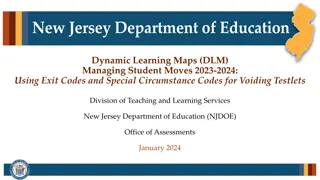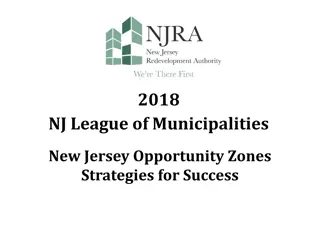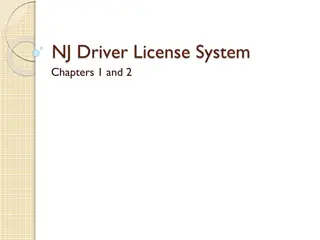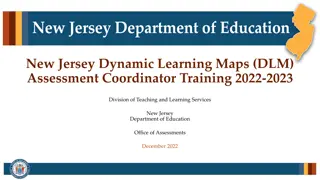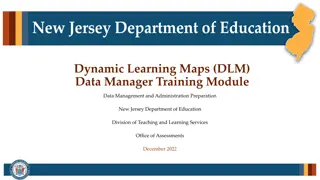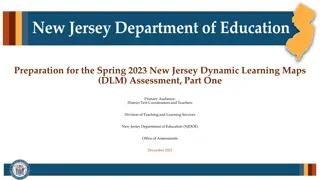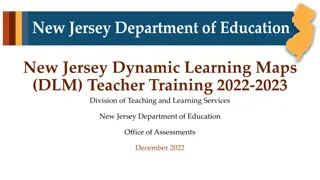New Jersey Dynamic Learning Maps Teacher Training Overview
Guidelines and information for New Jersey Dynamic Learning Maps (DLM) Teacher Training for the 2023-2024 academic year, including criteria for student participation, assessment policies, test administration details, and required training for educators. The training covers preparation for the DLM assessment, use of documents and modules, and professional development resources.
Download Presentation

Please find below an Image/Link to download the presentation.
The content on the website is provided AS IS for your information and personal use only. It may not be sold, licensed, or shared on other websites without obtaining consent from the author.If you encounter any issues during the download, it is possible that the publisher has removed the file from their server.
You are allowed to download the files provided on this website for personal or commercial use, subject to the condition that they are used lawfully. All files are the property of their respective owners.
The content on the website is provided AS IS for your information and personal use only. It may not be sold, licensed, or shared on other websites without obtaining consent from the author.
E N D
Presentation Transcript
New Jersey Dynamic Learning Maps (DLM) Teacher Training 2023-2024 Division of Teaching and Learning Services New Jersey Department of Education Office of Assessments January 2024
Preparation for the DLM Assessment This presentation provides guidelines for: The use of documents and modules to prepare for the NJ DLM Year-End (YE) spring assessment; and The required training for teachers. Your School or District Assessment Coordinator will answer any questions you may have about the assessment. 2
Table of Contents Topic DLM General Information Slides 4 to 15 NJ and DLM Required Teacher Training 16 to 28 Preparation for Instruction and Assessment 29 to 36 Professional Development and Educational Resources 37 to 40 Educator Portal Surveys and Supports 41 to 43 DLM Practice Testlets 44 to 47 Test Administrators Manuals and Resources 48 to 52 Reminders and Other Presentations 53 to 55 3
Participation Criteria Guidelines Students with the most significant intellectual disabilities are the only students eligible to take the New Jersey Dynamic Learning Maps (DLM) alternate assessment. IEP teams must use the NJ DLM Participation Criteria Guidelines to make this determination. 5
Student Policies Students in grades 3 through 8 and grade 11 participate in the English language arts and math assessments. Students in grades 5, 8, and 11 also participate in the science assessment. Retained students in grades 3 through 11 must participate in the DLM. Current grade 12 students who did not participate in the spring 2023 administration of the DLM when in grade 11 are encouraged, but not required, to participate in the spring 2024 administration. 6
DLM Year-End (YE) Model and Test Window New Jersey uses the DLM Year-End (YE) model which is a computer-based assessment based on the NJSLS and DLM Essential Elements (EEs). The DLM IE testlets were made available to NJ educators in the fall of 2021 to assist with gathering benchmark data for DLM students in the absence of spring 2021 DLM data. Results from the DLM IE testlets are not predictive of student performance on the DLM YE spring assessment. Test administration window is April 8 to May 31, 2024. Districts should begin testing early enough to ensure completion during the testing window. May 31, 2024 is the last day of testing, therefore students should consistently participate in the assessment by completing required testlets from April through mid-May. 7
YE Model Adaptive Assessment The DLM assessment is a computer adaptive assessment. The computer adaptive process for the assessment includes: 1. The teacher completes the student s First Contact Survey indicating current level of demonstrated skill level, etc. These answers help the system pick the first set of test items. 2. A student takes a small set of items, called a testlet, then the system considers the level of difficulty of the test items and the student s performance (correct or incorrect answers). 3. Based on the student s performance another testlet is selected, which contain items that are around the same level, somewhat easier, or somewhat harder than the last testlet (same, lower, or higher- level skills are selected). This is an iterative process until the testlets address all Essential Elements in the YE test blueprint. The number of testlets varies based on grade and content area tested. 8
DLM Computer Based Testing A small percentage of students will be assessed outside the system via DLM teacher administered tests. The student will not view the computer screen as the teachers will administer the questions based on their view of the testlets on the computer. When this occurs, a teacher will be asked to gather objects to use during the test. A student may sometimes have one teacher administered testlet, and the next testlet may not be teacher administered, depending on the adaptive nature of the test and modifications to the level of testlet assigned to the student. Information on teacher administered testlets is found in the DLM Test Administration Manual. 9
Obtaining Test Specifications Grade specific test specifications which delineate which DLM Essential Elements and skill statements are tested in the YE model should be reviewed. Use the links to the Educator Resource pages for information on: Test specifications for ELA and math Test specifications for science 10
Test Administrator Responsibilities Test administrators: Are classroom teachers Administer assessments to students and assist in the selection of accessibility features and necessary supports Complete First Contact surveys and Personal Needs and Preferences (PNP) Profiles Verify correct students are on assigned rosters Administer practice tests Review Test Administration Manual Review Accessibility Manual Contact your School Assessment Coordinator if you have questions. 11
DLM Educator Roles Teachers maynot fulfill the other DLM designated roles: District/School Assessment Coordinators District Data Manager Teachers will receive their DLM login ID and password after their District Data Manager uploads the teacher s information into the DLM Educator Portal. 12
Additional District-Level Roles and Responsibilities There are three additional roles for district-level staff in the DLM testing process. The School and District Assessment Coordinators: Are the point of contact for all assessment responsibilities excluding the tasks of the two roles listed below. Oversee and assist teachers in their roles. Schedule teacher training and ensure proper test administration. The Technology Representative will load the DLM Kite application onto computer devices in order to allow for access to the practice tests and to administer spring testing. The Data Manager will upload and review data to create the classroom test rosters, obtain all login IDs for the district, and add new students to the system as necessary. 13
Test Administrator Tasks Complete District teacher training (NJDOE PowerPoint modules and DLM training site modules) and implement instruction related to New Jersey Student Learning Standards (NJSLS) and DLM Essential Elements (EEs). Review DLM materials including test blueprints, manuals etc., and review professional development modules as needed. Complete First Contact (FC) and Personal Needs and Preferences (PNP) Profiles once rosters are completed by March 18, 2024. Attend District training on preparation for NJ DLM, administer practice tests, create testing schedule & produce student testing folders in March 2024. Conduct NJ DLM testing April 8 to May 31, 2024. Note: Districts should begin testing early enough to ensure completion during the testing window. 14
Steps for Teachers Administering the DLM Timeline Action Steps September January Implement instruction related to New Jersey Student Learning Standards (NJSLS) and DLM EEs Review DLM materials including, test blueprints, EEs, etc.; and Review professional development modules as needed Complete teacher training (PowerPoint and DLM training site modules) February March Complete First Contact (FC) and Personal Needs and Preferences (PNP) Profiles once rosters are completed Review training materials including DLM Accessibility Manual Complete training on Preparation for NJ DLM Administer practice tests Create testing schedule Produce student testing folders April 8 through May 31 Administer the DLM assessment to students Note: Districts should begin testing early enough to ensure completion during the testing window. 15
Required Teacher Training: PowerPoint and DLM Training Site 16
DLM Training Site Modules The DLM training site is used to provide the mandatory teacher training modules required by NJDOE. District or School Assessment Coordinators will conduct and oversee the training of teachers using both the DLM training site and the NJ teacher training materials. Note: Test administrators who passed all the required training in the fall do not need to repeat the test administrator training for the spring 2024 administration. 17
Returning Test Administrator for 2023-2024 In most cases, Returning Test Administrators tested students with the DLM last year. Someone is designated a Returning Test Administrator if, in the 2022-23 school year, they: Passed all DLM modules; and Received a certificate in their current district. Someone is still considered a Returning Test Administrator if they: Were designated as a back-up Test Administrator; and Passed the modules/received certificates (even if they did not administer the DLM last year). Note: Test administrators who passed all the required training in the fall do not need to repeat the test administrator training for the spring 2024 administration. 18
New Test Administrator for 2023-2024 Someone is designated a New Test Administrator if, in the 2022-23 school year they didnot take and pass the DLM modules. Test administrators are only considered "returning" if they have no gaps in taking and passing the annual test administrator training. Therefore, if test administrators did not take the test administrator training for the 22- 23 administration because the DLM was not administered in the district, they are designated "New" test administrators for 23-24 and must take and pass the "New" test administrator training. Note: Test administrators who passed all the required training in the fall do not need to repeat the test administrator training for the spring 2024 administration. 19
Administered DLM Last Year and Changed School Districts The DLM training site accounts are associated with teachers email addresses. If you are listed as a New Test Administrator on the DLM training site because you are working in a different district than you were last year and/or your email address has changed, even though in 2022-2023 you passed the module post-tests and received certificates, this can be revised. Present the test administrator training certificates to your Assessment Coordinator and ask that they email assessment@doe.nj.gov and DLM Support to request that your status be changed in the system to a Returning Test Administrator. 20
Required Reading Download DLM s Guide to DLM Required Test Administrator Training for important information on: logging into the DLM resetting passwords post-tests facilitated versus self-directed training, etc. 21
DLM Required Training for Returning Test Administrators The DLM required training is one module titled, Returning Test Administrator Training Review of the DLM Alternate Assessment System. This module is approximately 45 minutes. After viewing the module, the teacher must independently complete a four-part post-test. If you score below 80% accurate, the DLM system will provide and require additional training and post-tests. You may review the module and take the post-tests as many times as necessary in order to achieve 80% or higher. 22
DLM Required Training for New Test Administrators (1 of 2) The DLM required training is four modules. Part 1 About the DLM System Part 2 Understanding and Delivering Testlets Part 3 Test Administration and Scoring Part 4 Preparing to Administer the Assessment These modules are approximately 2.5 hours. 23
DLM Required Training for New Test Administrators (2 of 2) After viewing each module, the teacher must independently complete a post-test. If you score below 80% accurate on any post-test, you must review the training materials again and retake the post-test(s). You may take the tests as many times as necessary in order to achieve 80% or higher. There is also an optional module entitled Personal Learning Profile Training, which provides more information about completing a student s Personal Needs and Preferences (PNP) Profile and First Contact survey. There is no post-test for this module. This module is also available on DLM s website to view at any time. 24
Assessment Coordinator Schedules Training (1 of 3) Assessment Coordinators may train all Test Administrators as one group (Returning and New Test Administrators) using all five modules. After the training, each Test Administrator must: 1. Independently and separately login into the DLM training site; 2. Click on Facilitated Training (this tells the system you don t need to view the modules because someone showed them to you); and 3. Take assigned post-test(s) One post-test if a returning test administrator Four post-tests if a new test administrator 25
Assessment Coordinator Schedules Training (2 of 3) Assessment Coordinators may choose to split the group into a Returning Test Administrators group and a New Test Administrators group for training. After the training, each test administrator must: 1. Independently and separately login into the DLM training site; 2. Select Facilitated Training (this tells the system you don t need to view the modules because someone showed them to you); and 3. Take assigned post-test(s). 26
Assessment Coordinator Schedules Training (3 of 3) Be advised that even when trained in a facilitated setting alongside new test administrators, there is no facilitated option in the DLM Training site for returning test administrators, only self-directed. Upon logging into the DLM training site, returning test administrators will need to play the self-directed returning training video then proceed to the post-tests. The returning video includes the highlights of the four modules for new test administrators. 27
Individual Teacher Training The Assessment Coordinator may also choose to assign a time during school hours for Test Administrators to separately view the module(s) and take the post-test(s). To independently complete the modules and post-tests: 1. Login into the DLM training site; 2. Select Self-Directed Training ; 3. View the module(s); and 4. Take assigned post-test(s). 28
How To Access the Required DLM Training See the Guide to DLM Required Test Administrator Training 2023-2024 for information on use of login ID, password updates, DLM training site access, etc. The district Data Manager will provide login ID to Test Administrators if they do not already have one. 29
Preparation for Instruction and Assessment 30
Instructional Program Preparation Teachers and school program staff must review the EssentialElements (EEs) and implement individualized instruction related to the EEs. The Essential Elements are skill statements written to align with the NJSLS at an appropriate linkage level for students with significant cognitive disabilities. EEs and nodes (specific skills) are important to review and address during instruction. Note that ELA and math have five linkage levels, while science currently has only three linkage levels. More details are presented in upcoming slides. 31
Use of the Test Information Use of the Essential Elements, linkage levels, and nodes (skill statements related to the map), and the YE test blueprint will guide instruction, assist in selecting individualized targeted skills related to the NJSLS, and help prepare students for the DLM assessment. School program staff and district curriculum specialists should assist in the development of instructional plans based on the DLM Year-End (YE) test blueprints. DLM also provides Professional Development (PD) modules that are designed to teach conceptual areas related to NJSLS and the DLM EEs. 32
What do teachers/test administrators need to do this school year to prepare for the DLM? (1 of 2) 1. Review the training materials designed to prepare you for instruction aligned to the Essential Elements (EEs) and administration of the DLM. 2. Prepare your students by providing instruction linked to the NJSLS and the related DLM EEs. A. Develop instructional lessons related to the EEs. EEs are comprised of linkage levels and nodes that show how skills are related and build on one another. Linkage levels and nodes help teachers understand how to route instruction for the diverse population of participating students. B. Incorporate computer use, manipulatives, familiar texts, writing tasks, and DLM skills into your instruction. 3. Complete required DLM training. 33
What do teachers/test administrators need to do this school year to prepare for the DLM? (2 of 2) 4. View 2 3 minute Instructional and Informational videos on the Educator Resource Videos page in preparation for assessment. 5. Complete in the First Contact and Personal Needs and Preferences (PNP) Profiles for each student on your rosters in February 2024. It may be helpful to begin these surveys on paper so that you can consider the responses. 6. Prepare students for the DLM through practice tests. 7. Check NJ DLM webpage for training material updates. 34
How to Find the Linkage Levels (1 of 2) Another way to view the EEs is the Currently Tested webpages by content area: Mathematics ELA Science Each EE is a clickable link that reveals the linkage levels and nodes for the EE. This resource is particularly helpful in determining routes of learning for individual students. Essential Elements with a gray flag icon beside them are not assessed in the YE model but can still be useful in instruction. 35
How to Find the Linkage Levels (2 of 2) Example of Grade 3 from the Currently Tested Essential Elements for ELA Note: Essential elements marked with a gray flag ( )are not assessed in Year End states. Grade 3: Essential Elements Assessed EE.RL.3.1 Answer who and what questions to demonstrate understanding of details in a text. EE.RL.3.2 Associate details with events in stories from diverse cultures. (gray flag indicating not assessed in Year End states) EE.RL.3.3 Identify the feelings of characters in a story. EE.RL.3.5 Determine the beginning, middle, and end of a familiar story with a logical order. (gray flag indicating not assessed in Year End states) EE.RI.3.1 Answer who and what questions to demonstrate understanding of details in a text. gray flag indicating not assessed in Year End states) EE.RI.3.2 Identify details in a text. EE.RI.3.3 Order two evens from a text as first and next . EE.R.3.5 With guidance and support, use text features including headings and key words to locate information in a text. gray flag indicating not assessed in Year End states) 36
Test Blueprint A test blueprint pdf is available for each subject. Blueprints list the EEs assessed at each grade. The test blueprints can be found on NJ s page of the DLM website: Under the Instructional Resources filter. Example of the Grade 6 blueprint for ELA 37
Instructional and Informational Videos Instructional and Informational videos can be obtained through the Educator Resource Videos page for topics including: Accessing and maneuvering through Education Portal Testlet Overviews These videos are most beneficial when viewed in conjunction with the training modules. 38
Professional Development and Educational Resources 39
Professional Development DLM Professional development modules developed by the University of North Carolina (UNC) support the design and delivery of this instruction. These modules are different from the required DLM training modules, but are highly recommended and optional. The PD modules on topics related to math, writing, reading, and science instruction provide information that is useful for classrooms and school programs. Topics are broad and include information about alternate pencils (writing topic), algebraic thinking, predictable chart writing, place value, etc. Viewing the PD modules is encouraged and topic selection is based on a teacher s interest in specific areas. Modules can be sorted according to DLM Claim or in alphabetical order. 40
Obtaining PD Checklist Professional development modules are sorted by the alphabetized list or claims list. A check list is available to download so you may track which modules you have viewed. Access the website for the DLM Professional development modules. 41
Recap of Materials Using the following DLM resources will help to instruct your students and prepare them for assessment: DLM Professional development modules Essential Elements which note the grade level and target skills Test Blueprints for list of tested skills 42
Educator Portal Surveys and Supports 43
Online Surveys During February 1 through March 18, 2024, you will need to complete the First Contact (FC) survey and the Personal Needs and Preferences (PNP) Profile for each student on each of your subject test rosters. Please review the DLM Accessibility and Test Administration manuals in order to consider which survey responses and accessibility features to use for each student. More information on the FC survey and PNP Profiles are found in the Educator Portal User Guide. 44
Accessibility Supports DLM offers a variety of accessibility supports during assessment. Some supports are delivered through the Kite Student Portal and are determined by responses to the First Contact (FC) and Personal Needs and Preferences (PNP) Profile. Category 1 supports delivered via Kite include magnification, inverted color choice, color contrast, overlay color, and computer spoken audio. Category 2 supports require additional tools and/or materials. These include Single-switch System/PNP Profile Enabled, Two-switch System, individualized manipulatives, etc. Category 3 supports provided outside the system include Test Administrator read aloud, sign interpretation of text, language translation of text, etc. Pages 21 24 of the Accessibility Manual provide additional details explaining the support categories. 45
Practice Testlets Practice testlets are available in DLM Kite Student Portal and should be administered to students prior to March 2024. Practice testlets relate to some accessibility features the student may use. Select the practice testlets ( demos ) based on the PNP features. The purpose of using the practice items is to give the student experience with the online test experience prior to answering live test questions. This allows the student and teacher to be aware of the computer features, and helps to determine whether the student or teacher would drive (use the computer mouse) during testing. 47
Practice Testlet Access Refer to the Test Administration manual along with pages 1 and 2 of the Guide to Practice Activities & Released Testlets Year-End model for information on accessing practice testlets. Personalized practice testlets are not available in the DLM system. The practice test button seen on screen after logging in to a student s account does not function. Do not use the student s login ID and password when looking for practice tests. Practice testlets login ID always start with demo for the login info. 48
Engagement Activities DLM engagement activities are included in each testlet. The engagement activities are meant to give the student a context for the questions, taps and activates prior knowledge and experience, and/or introduces the concept(s) to be addressed. The engagement activities do not require a student response to a DLM test question. The test administrator will engage the student in the activity and may ask factual questions without leading the student to answers. 49
Test Administrators Manuals and Resources 50




